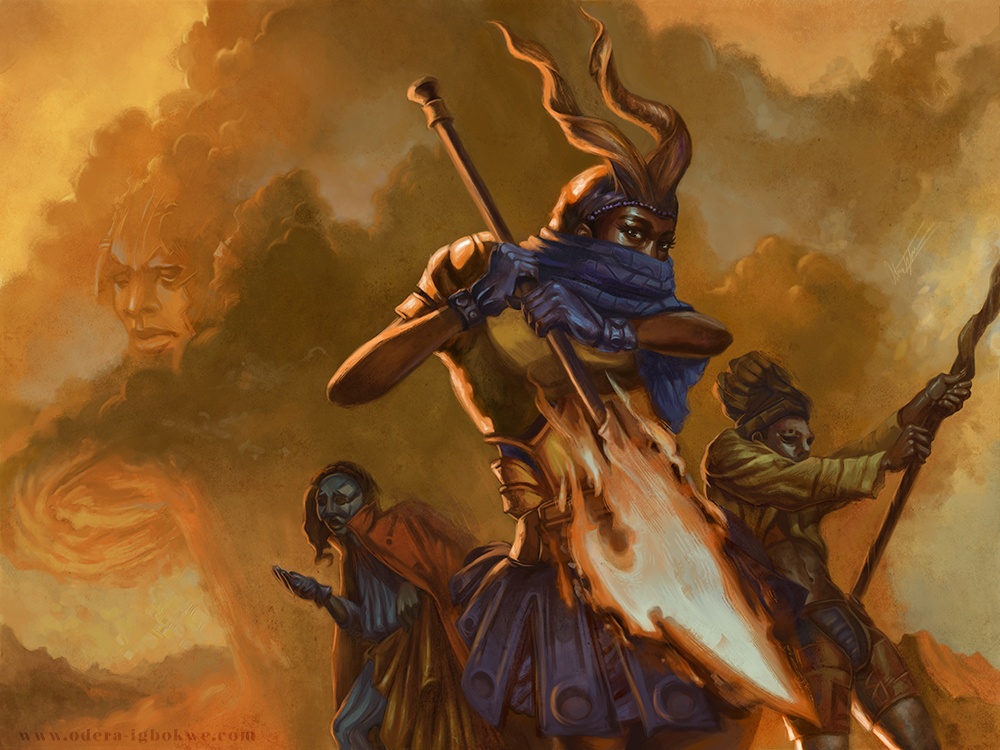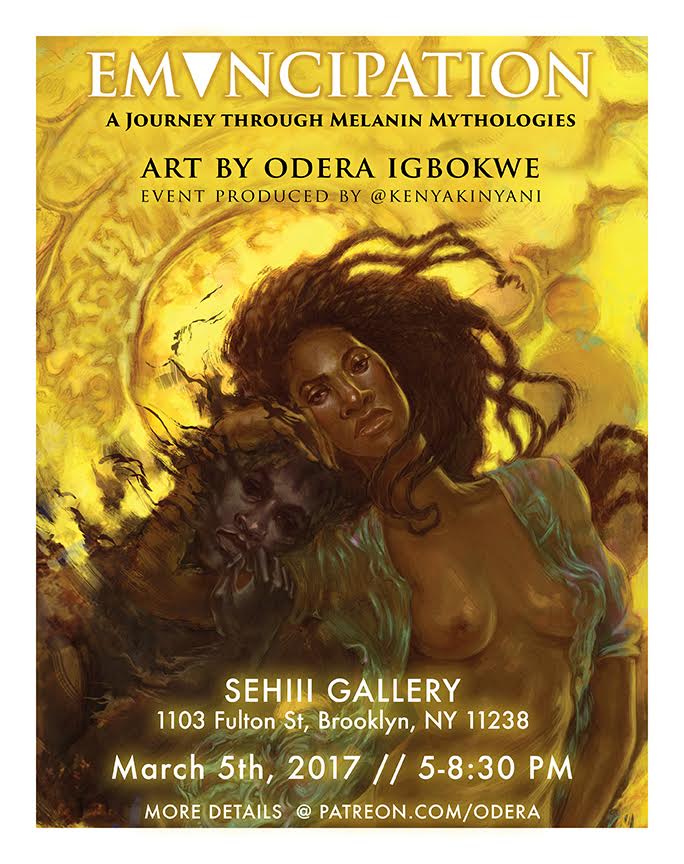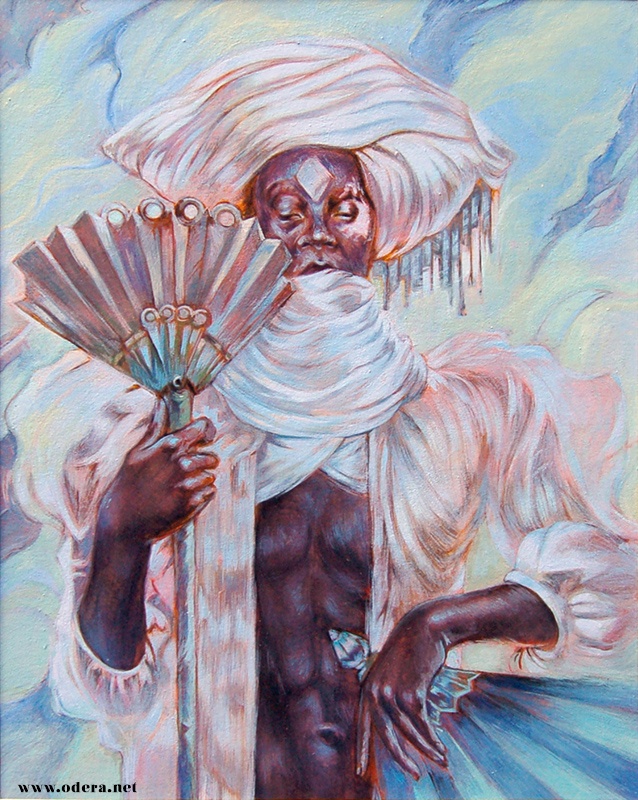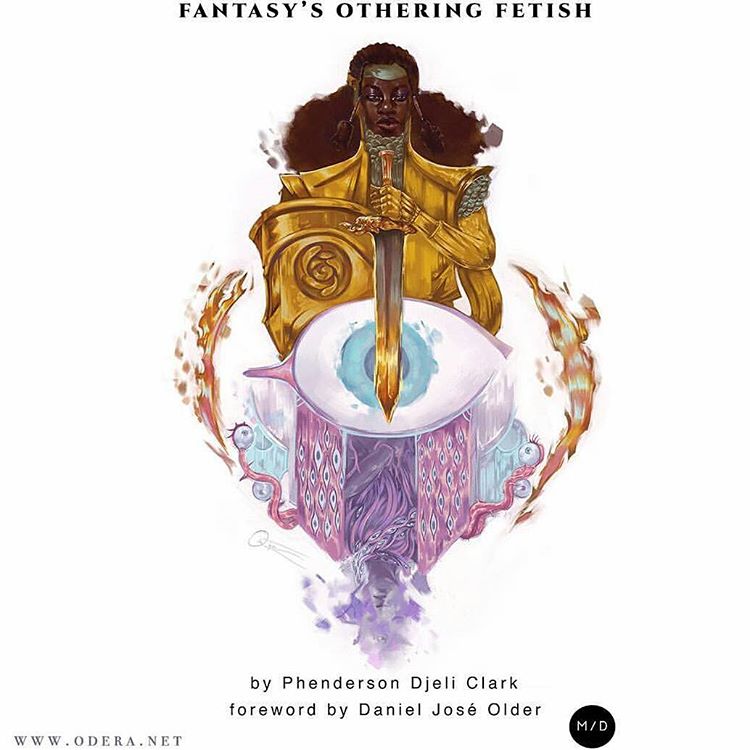I stumbled upon Odera Igbokwe’s take on the Sailor senshi all decked out as women with darker skintones some while ago when the art when viral. I’m a big Sailor Moon fan and I also love fanart so it was a refreshing take on the beloved womenfolk of my childhood. I keep coming back for more because Odera continues to create more inclusive illustrations that seat not just people who look like me, but many belonging to the African Diaspora, in fantasy settings.
Everyday I know that I will venture out into a world that will use certain images and pictures of people who share my features in narratives that seek to invalidate us, to destroy us. While I’m getting better at articulating the feelings that accompany this life-long struggle this doesn’t mean that I’m not overwhelmed at times.
Odera’s pieces are wonderful to see because while we all know that Black girls are magic and Black folk in general must have some kinda magic to be so resilient against what history has dealt us, I’m still very much greedy for more and better representation of us in a positive light by folks who look like us. The artist Odera Igbokwe is very much one such person. I’d love to put you on to them since you’re here.
Black Nerd Problems: Your redesigned Sailor Moon fanart was everywhere I can remember when it went viral — what was your first impression of all the exposure it received? How did you make you feel that so many people were responding to it positively?
Because this current themed series of yours, “EM▼NCIPATION: A Journey Through Melanin Mythologies”, actually started with these ladies in an effort to center the African diaspora and queer people of color in fantasy-themed art, would you consider the Sailor senshi muses in some regard?
Odera: Hellooo Black Nerd Problems! I’m such a huge fan of the work you all are doing, and I’m excited to dive into these questions!! I feel like I should explain a few things before getting into my redesigns of Sailor Moon.
“Melanin Mythologies” is my Patreon project that focuses on making fantasy illustrations and paintings that center the African Diaspora, QPOC, and all the magical intersections in between. People subscribe and get fun rewards like exclusive artwork, custom portrait drawings, and other fun goodies. Patreon is a really beautiful platform that gives power to the creators and allows for more unique under-represented content!
EM▼NCIPATION: A Journey Through Melanin Mythologies, is a gallery event happening in Brooklyn on March 5th! It’s going to be showcasing all the work I’ve been making for the Patreon!
*Phew* Now that I’ve described those, I can say that none of these projects would exist if it weren’t for my redesigns of Sailor Moon. Perhaps I wouldn’t exist if it weren’t for Sailor Moon either. Sailor Moon is so influential to my upbringing, and I love how it truly celebrates the power of friendship and sisterhood.
After graduating from Rhode Island School of Design, I was living in a pretty toxic environment and it was deeply affecting my ability to make new work. So I assigned myself the task of making fanart of each of the Sailor Scouts. It started as a way to keep up the momentum of making new work, and evolved into a lowkey indulgent, highkey joyful celebration of the African diaspora.
While most of the feedback from the Sailor Moon redesigns were positive and a major checkpoint in my career, not all of the responses were positive. There was a bit of misogynoir masked as valid critique (“why did you make them so ghetto fabulous”, “this is erasure of the original Japanese cast”, “they are all ugly now” etc.). Comments like that really reminded me of why I decided to make all of them Black women.
In my initial alternate universe, they were all different races and ethnicities at an international school. But after doing a drawing of Sailor Mercury with a blue mini fro, I thought it would be even more powerful to create a cast of 10 women of the African diaspora as Sailor Scouts.
Black people are often reduced to tokens, and Africa reduced to a monolith. And yet there is so much diversity within the African diaspora.
Black people are often reduced to tokens, and Africa reduced to a monolith. And yet there is so much diversity within the African diaspora. So I wanted to explore that through our different body types, hair styles, skin tones, etc. Suddenly the project became much more exciting when I thought “Sailor Moon with dark skin and pastel pink box braids! Mars with a fiery mane and eternal side eye! Saturn with a deadly twist out!”
BNP: To elaborate more on the theme and the title of this series in your own words you describe it as:
[quote_simple]“EM▼NCIPATION from long distance relationships.
EM▼NCIPATION from US fascism.
EM▼NCIPATION from erasure and exclusion.
EM▼NCIPATION from gender roles and the centering of masculinity
EM▼NCIPATION from voices that tell you aren’t enough or that you’re too much.”[/quote_simple]
Why did you feel now, or more recently was a necessary time to push forward and seek emancipation from these things and more? What have you experienced or seen happening that created the need for this series to be created and blossom to what it is now?
Odera: EM▼NCIPATION seems to be the connecting narrative thread in all the images at the show. So my description is a proclamation for myself and a call to arms for others. I want people to come to EM▼NCIPATION: A Journey Through Melanin Mythologies, see the body of work, and reflect on what EM▼NCIPATION means for them. We all have a journey to freedom, but it’s up to each of us to figure out what that journey is and what responsibilities we have as a community.
I think the timing has all happened really organically. And there isn’t one single piece that defined the need for EM▼NCIPATION: A Journey Through Melanin Mythologies. The show was born from the work I’ve been doing on Patreon. The Patreon was born from my Sailor Moon redesigns and doing a spotlight on Black History Month illustrators, painters, and artists. And all of those things have come from my creative desires I’ve had since I was a child.
BNP: Something I absolutely adore about you is that, in what many may feel is a competitive field of work, you stay promoting other folks who create art with an emphasis on those who come from marginalized backgrounds. One could just scroll down your Twitter page and see the variety of different folks. In fact, your Black History Month thread celebrating favorite illustrators of the African diaspora that you tweeted out last year is still going strong. Why is this an important task for you? Why do you seek to celebrate others?
For #BlackHistoryMonth I’m celebrating my favorite illustrators of the african diaspora. 1st is #ThomasBlackshear pic.twitter.com/xnhKjk7qrE — Odera.net (@Odyism) February 1, 2016
Odera: The art world can be competitive. There will always be someone with better draftsmanship, better use of color, a better storyteller, etc. But the reality is that there is only one Odera Igbokwe, and no one will ever be better at being me. So while I’m extraordinarily ambitious, I’m not very competitive with other people. All I want is to uplift my fellow artists, especially those who are under-represented or from marginalized backgrounds.
All I want is to uplift my fellow artists, especially those who are under-represented or from marginalized backgrounds.
Whenever we (nerds, artists, etc.) have conversations about representation and Diversity™, it seems to fixate on big IPs and a more Diverse™ cast of fictional characters. That simply isn’t enough for me. I am infinitely more interested in supporting and fighting for under-represented creators. Even in my own work, I encounter not having the lived experience to address certain things. So I just want to see more under-represented stories and amplify the voices of other creators.

BNP: Representation-wise, while I love that POC, women, and queer people are at the center of your work, I’d hate to gloss over you showcasing and introducing to some your Nigerian heritage. Several pieces of this series are your stylized interpretations of Nigerian deities like Oya and Obatala. In your heart of hearts, what spoke to you to include them in this series?
Odera: I think my initial interest in them was more on the shallow side. I’d think to myself “Okay but imagine a Final Fantasy-esque RPG and the summons were inspired by Nigerian-diasporic deities?” But now it’s become a reclamation of identity. I am naturally drawn to them, and now I try to respectfully alchemize them into my own meditative paintings. As a child of immigrants, there has always been that tension and othering that occurs between the country of your parents and being an ~American~. Since I am Queer it adds another layer of dissonance and being very “Un-African.”
As a child of immigrants, there has always been that tension and othering that occurs between the country of your parents and being an ~American~.
Since I am Queer it adds another layer of dissonance and being very “Un-African”.
But at the end of the day there are certain things no one can take away from you or your spirit (especially if those things are actual spirits). In addition to the visual arts, I’ve also studied different Afro-diasporic dance styles. And it’s always fascinated me how the major juice of African mythologies aren’t from written text, but the dance and the songs. So over the years I’ve just accepted this connection and natural urge to explore these deities through movement, song, and in my own art practices.
BNP: Your artwork is on the cover of “Fantasy’s Othering Fetish“, an ebook that tackles the erasure of POC in fantasy settings. It’s a fitting marriage. How did this come to be? Were you approached by Phenderson Djeli Clark? What’s the story behind this collab?
Odera: MediaDiversified put out a call for artists. Before I knew it, multiple people had tagged me on the post. It was really exciting to be able to create work for them. There aren’t a ton of opportunities where there’s the alignment between such specific mission statements in a medium like Fantasy. They gave me a lot of freedom on the project, and when I boiled it down, my personal response to the othering fetish was “Okay but I want to block the white gaze with all my might.”
BNP: I’m a huge fan of the Final Fantasy video games and imagine my poor nerd heart spasm when I discovered you were illustrating characters with the classic RPG archetypes (Knight, Mage, Archer, etc) and even the Final Fantasy-esque summons. Out of the archetypes — which one would you be? Out of the Final Fantasy Espers/Eidolons/Aeons which ones do you remember actively calling on more often to aid you in battle? Which were faves of yours?
Odera: Full disclosure, I think about RPG archetypes & classes all the time. If you’re my friend, or if I’ve seen you in a great outfit then I have probably created an RPG build of you. My partner and I have discussed at length and it’s become obvious that I would be a Summoner/Dancer. It’s a bit of an obvious choice, but it fits so well. The Summoner reflects my real life ability to envision and create works of art. The Dancer reflects my background in dance and love for really indulgent Magical Girl Transformation Sequences. It also fits nicely into the canon of Afro-Diasporic summoning dances (e.g., dancing for the Orishas). But perhaps I would summon through weird body rolls while eating pizza and making hand drawn runes.
Growing up my favorite FF summon was Shiva aka the high femme goddess of the blizzard. But recently I’ve questioned how appropriate or respectful it is to use the term Shiva, when it’s so far removed from the Hindu deity. I guess now I am quite fond of The Magus Sisters from FF10, Ultima and *in Aretha Franklin voice* her “Beautiful gowns” from FF12. And the emotional plot of FF9 (my favorite) really made each summon memorable (Alexander, Atomos, etc).
BNP: This will be your last show in the states before you actually move to Canada, what significance does this art show hold for you? What are you looking forward to: personally and as an artist?
Odera: 5 is a sacred number for me. The show is on March 5th. It’s been 5 years since I graduated from Rhode Island School of Design. And on the day of the show there will be exactly 50 days until I move to Canada to be with my partner. So I have really been doing a lot of reflecting on my personal journey over the past 5 years. I actually met my partner because of a viral post on Tumblr of me dressed as Sailor Mars (showing a bit too much thigh and LeggGGgggGggs). This happened right as I started the Sailor Moon redesigns, so it’s been a blessing to see my personal growth and artistic growth become so intertwined.
EM▼NCIPATION is kind of the final chapter of this story arch in my life. It’s the culmination and embodiment of my journey over the past few years. My vision for my career has become a bit more clear by preparing for this show. And I have lots of exciting things planned to continue the Patreon, Melanin Mythologies! I am *really* excited to show the work together as a physical collection for the first time, and see where I am 5 years from now.

See more of Odera on Twitter, Facebook and see more work up for sale here. As always, please feel free to support to support the artist on Patreon.






Show Comments